Tom's Hardware Verdict
The Toshiba N300 doesn’t impress, but it's better than the X300. Its specifications and warranty are fine for multi-drive storage solutions, but it doesn't excel in any performance category and must rely on tight pricing — an area where it currently falls behind the N300 Pro.
Pros
- +
Better warranty than the X300
- +
Larger cache than the competition
- +
CMR technology
Cons
- -
Weak all-around performance
- -
Poor power efficiency
- -
Pricing currently higher than N300 Pro
Why you can trust Tom's Hardware
Toshiba has been playing a little bit of catch-up in the NAS game, developing its own technology to push the capacity envelope. The Toshiba N300 is positioned as a “budget” network-attached storage (NAS) hard drive solution, sitting below the company's higher tier N300 Pro, as a large-capacity alternative to WD and Seagate. The best hard drives combine lots of space with acceptable spinning platter performance, and a focus on price per GB. How does the Toshiba N300 stack up?
For starters, the N300 comes paired with a thick 512MB cache and a moderate 3-year warranty. It's designed to be used in multi-drive environments with up to eight drives to deliver a decent level of performance for a small office/home office (SOHO) storage solution. In this it succeeds, but is it worthy?
Performance is generally what you'd expect from a modern 7200 RPM hard drive, which is to say that it's far slower than the best SSDs — as are all HDDs. But the N300’s respectable specifications and large cache could make it a solid alternative when priced right, as price per GB tends to be a major consideration for all HDDs. The N300 is fit for building a multi-drive environment where smaller retail drives won’t do, and it's better-optimized and supported than the popular shuckable alternatives. It's good for users who want a safe but affordable home or small business NAS storage solution.
The N300 slots in above lesser drives and competes well with Seagate's IronWolf, but pricing and availability remain challenges in any search for larger-capacity drives. That's going to be a key issue facing the new N300 18TB model. It currently costs $389 at Amazon, or $0.0217 per GB. That might seem okay, except the superior N300 Pro 18TB costs $309, or $0.0172 per GB. Obviously, the N300 price will have to come down to justify its existence. The current pricing likely stems from the fact that the N300 18TB is a recent addition to the N300 line, whereas the N300 Pro 18TB has been on the market since May 2022. The other overlapping N300/N300 Pro capacities tend to favor the non-Pro model by $20 or so on price.
Specifications
| Product | Toshiba N300 | Header Cell - Column 2 | Toshiba N300 Pro | Header Cell - Column 4 | Seagate IronWolf | Seagate IronWolf Pro | WD Red Pro |
|---|---|---|---|---|---|---|---|
| Capacity | 18TB | 16TB | 18TB | 16TB | 18TB | 18TB | 18TB |
| Model # | HDWG51JXZSTA | HDWG31GXZSTA | HDWG51JXZSTB | HDWG51GXZSTB | ST18000VN000 | ST18000NE000 | WD181KFGX |
| Pricing | $389.99 | $269.99 | $309.99 | $289.99 | $529 | $348.99 | $349.99 |
| Cost per TB | $21.67 | $16.87 | $17.22 | $18.12 | $29.44 | $19.39 | $19.44 |
| Interface | SATA 6.0 Gbit/s | SATA 6.0 Gbit/s | SATA 6.0 Gbit/s | SATA 6.0 Gbit/s | SATA 6.0 Gbit/s | SATA 6.0 Gbit/s | SATA 6.0 Gbit/s |
| Form Factor | 3.5" | 3.5" | 3.5" | 3.5" | 3.5" | 3.5" | 3.5" |
| Technology | CMR | CMR | CMR | CMR | CMR | CMR | CMR |
| RPM | 7200 | 7200 | 7200 | 7200 | 7200 | 7200 | 7200 |
| Sustained Transfer Rate | 281 MB/s | 274 MB/s | 281 MB/s | 281 MB/s | 240 MB/s | 260 MB/s | 272 MB/s |
| Cache | 512MB | 512MB | 512MB | 512MB | 256MB | 256MB | 512MB |
| Operating Power | 7.48W | 6.91W | 7.48W | 7.48W | 7.7W | 8.0W | 6.1W |
| Noise | 20dB (idle) | 20dB (idle) | 20dB (idle) | 20dB (idle) | 28dBA (idle), 30dBA (seek) | 20dBA (udle), 26dBA (seek) | 20dBA (idle), 36dBA (seek) |
| Workload Rate Limit | 180TB/yr | 180TB/yr | 300TB/yr | 300TB/yr | 180TB/yr | 300TB/yr | 550TB/yr |
| MTBF | 1.2M hours | 1.2M hours | 1.2M hours | 1.2M hours | 1M hours | 1.2M hours | 2.5M hours |
| Warranty | 3-Year | 3-Year | 5-Year | 5-Year | 3-Year | 5-Year | 5-Year |
The Toshiba N300 is the company’s entry-level NAS HDD model, playing the lesser sibling to the N300 Pro. It's available in a wide range of capacities but we’re looking at the newly released (as of November 2023) 18TB model today. The 18TB shares characteristics with the 14TB and 16TB models in terms of having 512MB of DRAM cache and a higher sustained data transfer speed. The 18TB sustains up to 281 MB/s, like the 14TB, with the 16TB coming in at a slightly lower 274 MB/s. As pricing right now is atypical, we’ve included the specifications for the 16TB which is currently priced more reasonably.
The N300 is directly compared to NAS drives from the two primary competitors, the Seagate IronWolf/IronWolf Pro and WD Red Pro, with the latter standing in for the Red Plus which currently has a maximum 14TB capacity. Drive tiers tend to be demarcated by the warranty in terms of coverage length and the workload rate limit, which in this case positions the N300 against the regular IronWolf. Lack of availability makes for volatile pricing and makes the drives difficult to compare by price — both the N300 18TB and IronWolf 18TB cost far more than they should at present.
Looking at the specifications, the N300 has a larger cache and higher sustained performance than much of the competition. However, it has a weaker 3-year warranty (aside from the IronWolf that also has a 3-year warranty). Both of these non-Pro models also have a 180TB/year workload rating, while competing drives offer 300TB/year — and 550TB/year on the WD Red Pro. Toshiba says the N300 series is rated for use in up to 8-drive NAS systems, whereas the N300 Pro can be used in up to 24-drive NAS installations.
Software and Accessories
Toshiba doesn’t offer much in the way of software downloads, as compared to Seagate and WD. The latter two rely more on a full-featured support system and are also better known by everyday users. For more serious, multi-bay systems, Toshiba puts its hardware forward to be used for something other than home systems. That said, a no-frills approach can be sufficient if you know what you’re doing, including for use in a home lab or SOHO.
A Closer Look
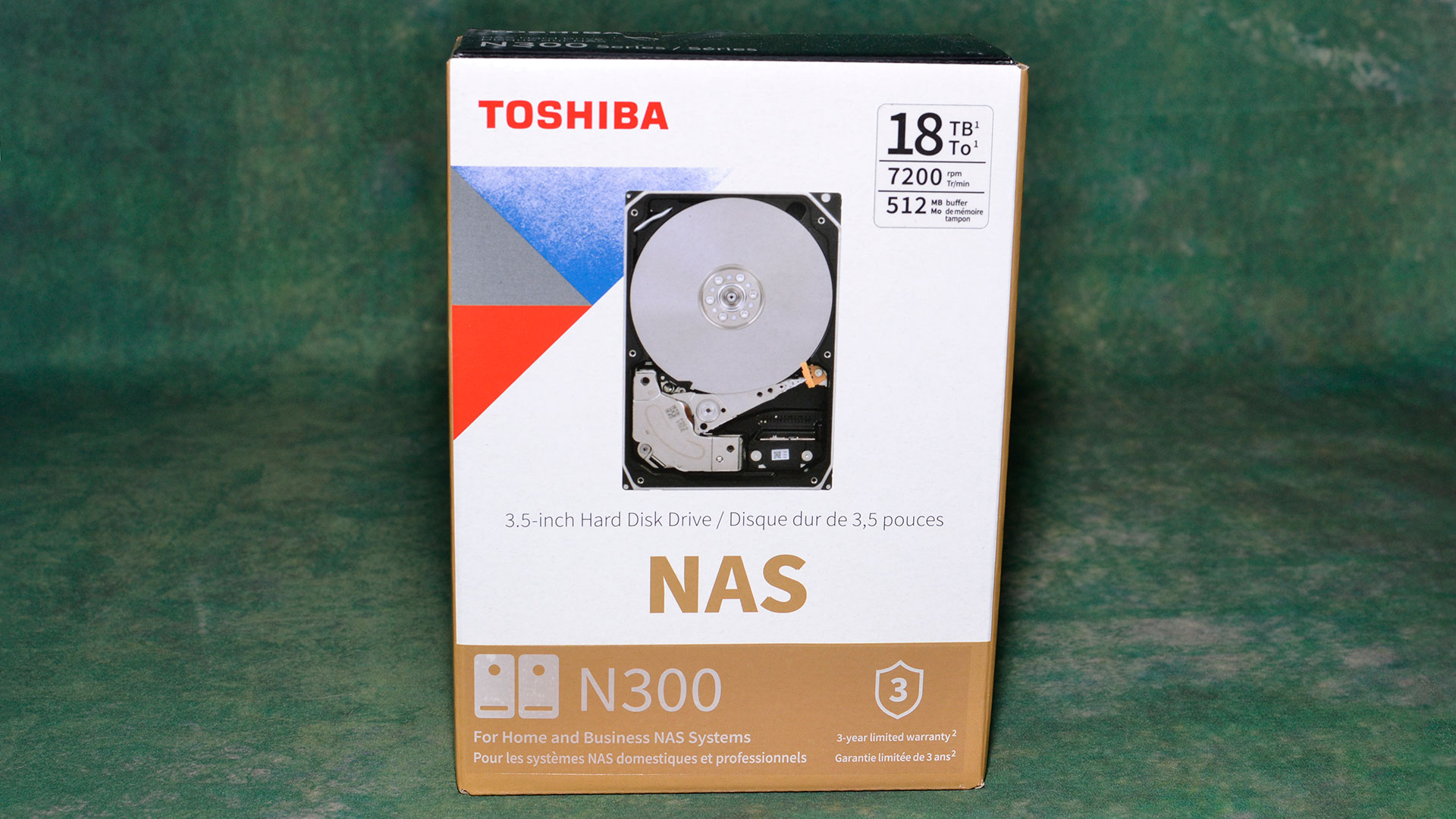
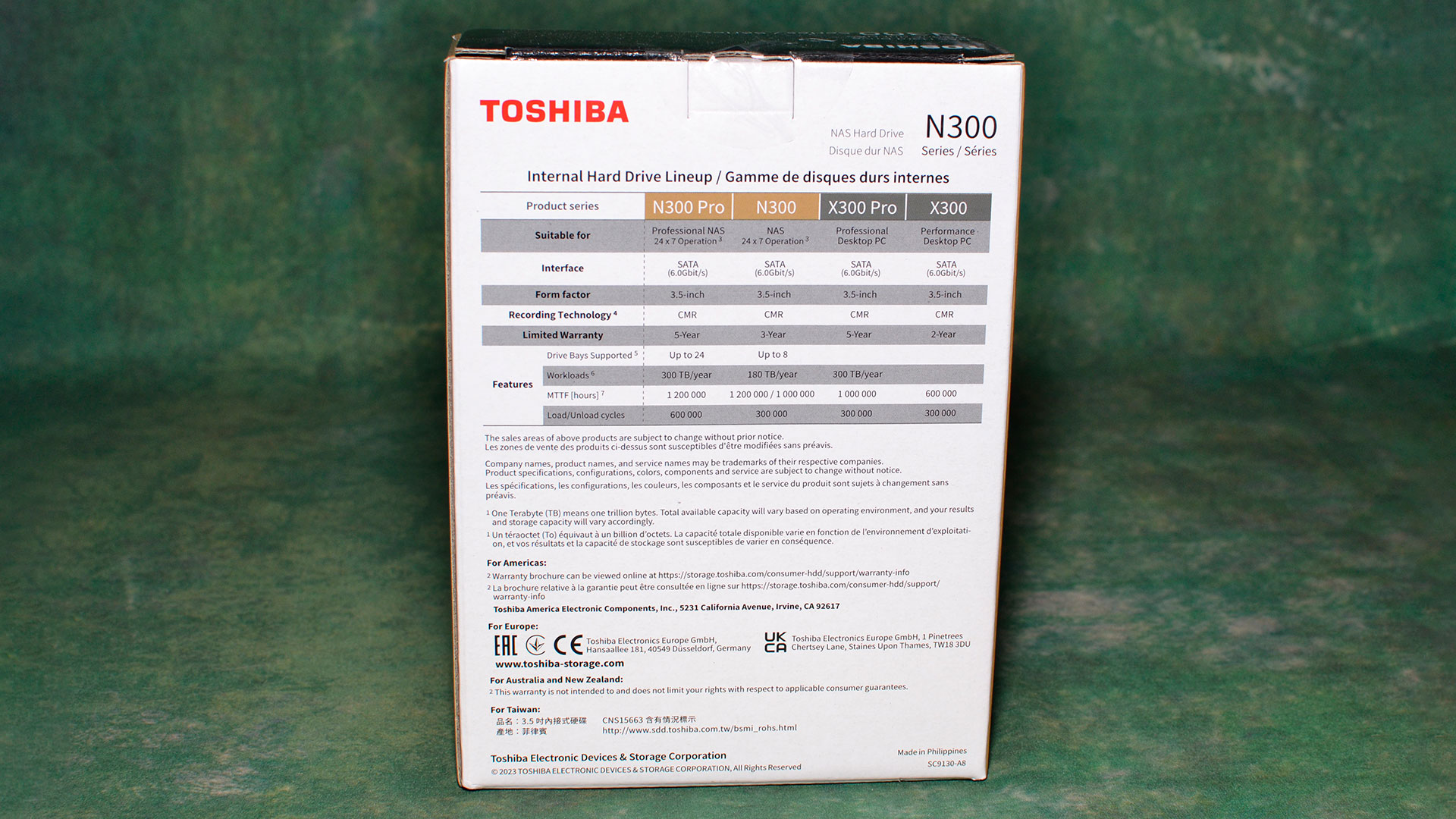
Toshiba compares the N300, N300 Pro, X300, and X300 Pro directly on the back of the box. We reviewed the X300 14TB earlier in 2023 to not much fanfare. That drive performed poorly and this is reflected by its anemic warranty. On the other hand, it has higher capacity options than the WD Black and Seagate FireCuda, which made it a possible pick for certain storage solutions in high-end desktops and workstations.
The X300 Pro is much more robust and is closer to the N300 Pro in specifications, with the latter emphasizing that it’s for use in multi-bay systems. The same is true of the N300 which has a weaker warranty but should be less expensive as a result. The various capacities may behave differently in actual use, however, which is something we'll see with the N300 Pro 12TB and 20TB models.
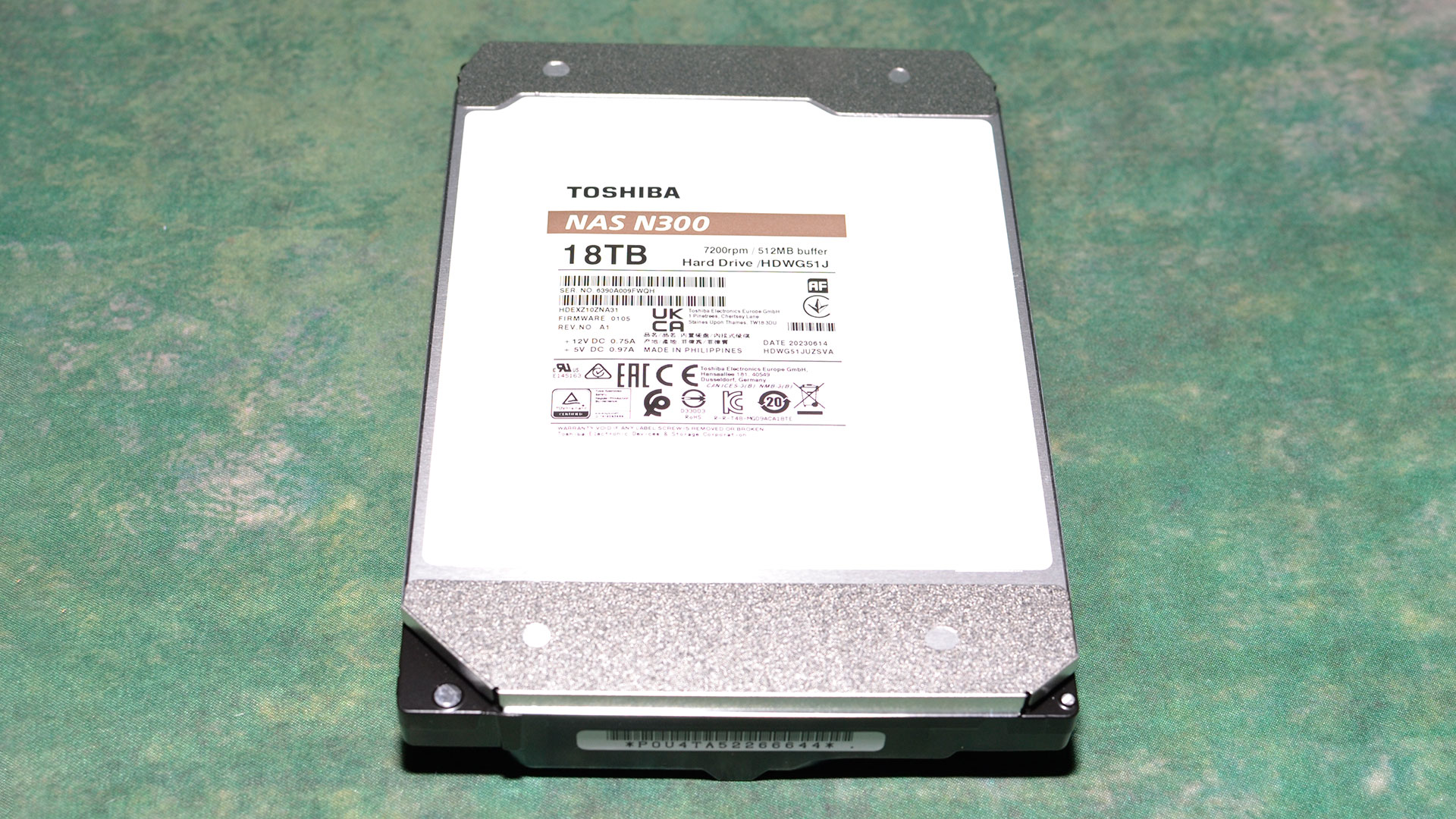
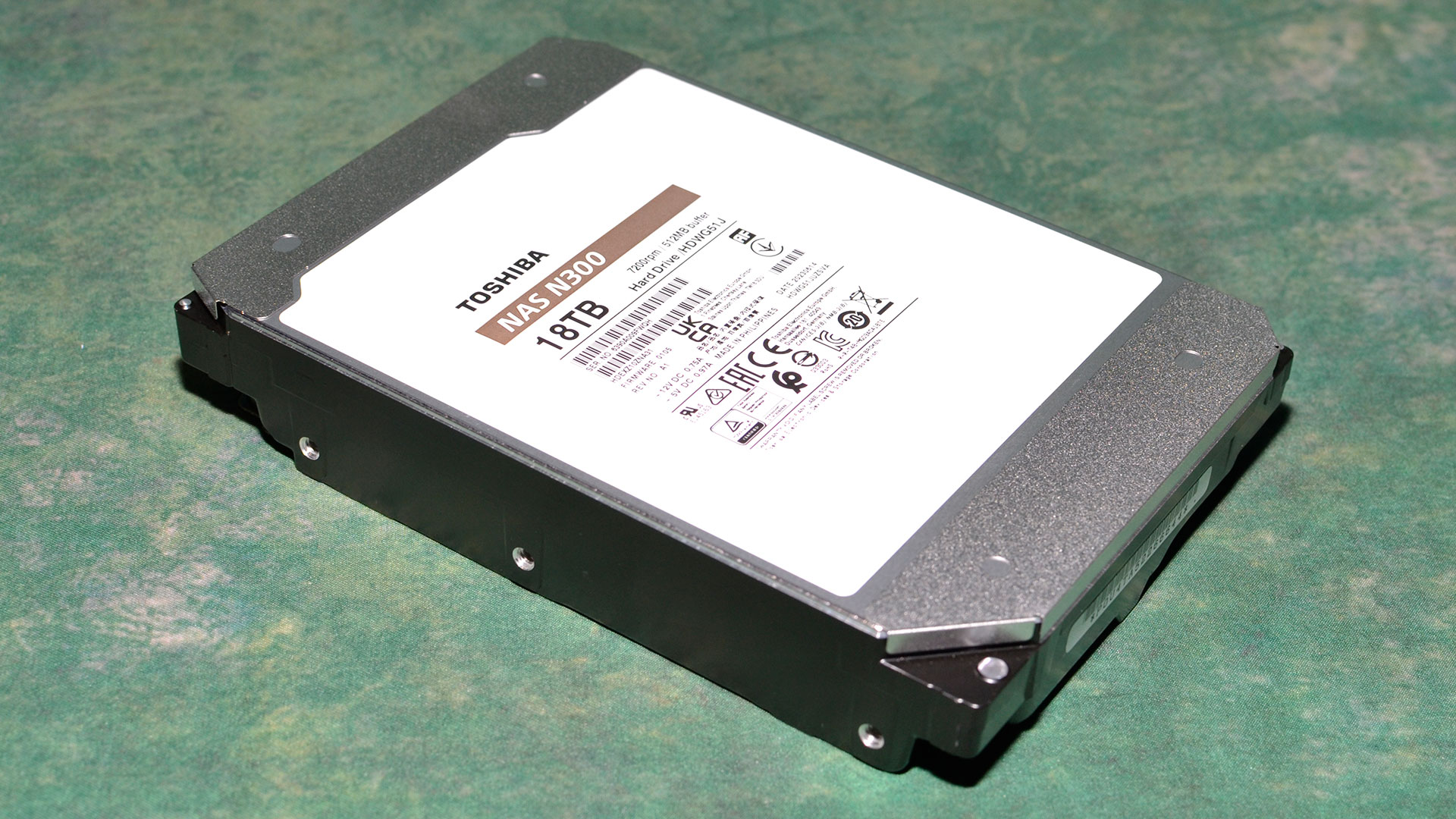
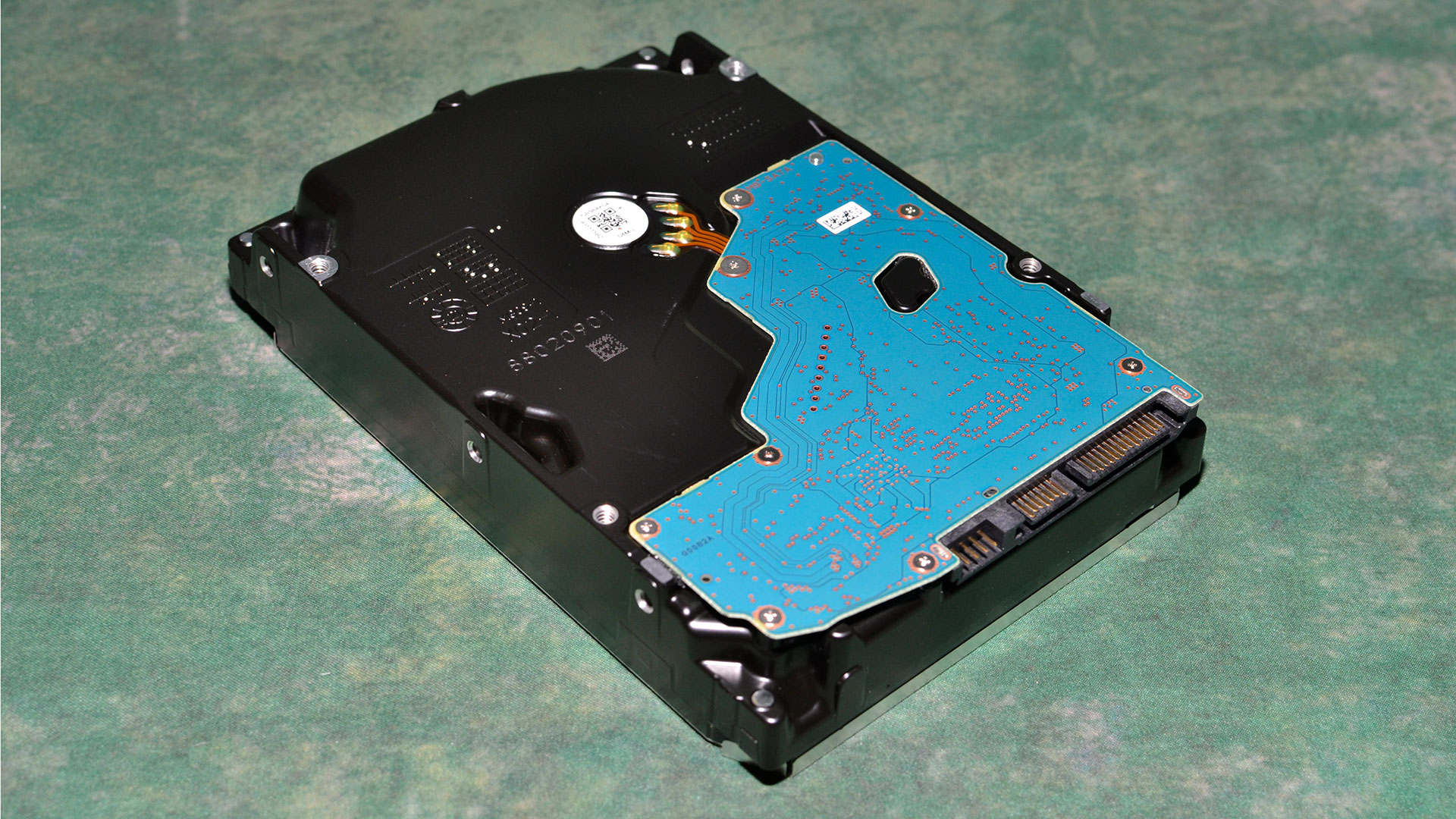
Toshiba plays the “white label” pitch to the hilt with an unremarkable drive exterior. Internally, Toshiba is using flux control microwave-assisted magnetic recording (FC-MAMR) to reach 18TB. This technology, like WD’s energy-assisted perpendicular recording (ePMR) as used in the WD Red Pro and WD Gold, provides a way to squeeze out more capacity.
The 18TB N300 uses nine platters with Toshiba’s Stable Platter Technology to minimize vibration. It has a relatively large cache with Toshiba’s Dynamic Cache Technology, features designed for multi-drive environments. Larger drives from all three manufacturers using newer technologies are on the way, however.
MORE: Best Hard Drives
MORE: Best SSDs
Get Tom's Hardware's best news and in-depth reviews, straight to your inbox.
MORE: How We Test HDDs And SSDs
- 1
- 2
Current page: Toshiba N300 18TB Features and Specifications
Next Page Toshiba N300 18TB Performance Results
Shane Downing is a Freelance Reviewer for Tom’s Hardware US, covering consumer storage hardware.